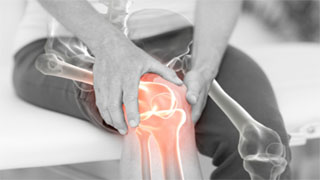
Knee synovitis is a synovitis, a membrane that covers the joint and surrounding tendons. Knee synovitis can cause various symptoms, including swelling and pain.
Knee synovitis is usually caused by overuse in people who are overactive, but it can also occur in people with various types of inflammatory arthritis that affect the knee joint. Although it cannot be cured, knee synovitis can be treated with anti-inflammatory drugs and other methods.
This article discusses the symptoms, causes, and treatment plans of knee synovitis.
Caused by liquid inflammation
Knee synovitis pain
When synovium is inflamed in knee synovitis, different anatomical points of the knee joint may be affected. The posterior cruciate ligament is the strongest ligament in the knee and one of the most commonly affected areas. It extends along the back of the leg, from the top of the bone between the knee and ankle, and from the bottom of the bone from the pelvis to the knee.
The suprapatellar region may also be affected. It is located on the front side of the leg, between the thigh bones and the quadriceps tendon.
Symptoms of knee synovitis
When people suffer from knee synovitis, they will experience various symptoms related to the disease due to inflammation and injury. Symptoms related to knee synovitis include knee swelling, joint pain, a warm feeling at the joints, and knee stiffness
What causes the symptoms?
Swelling caused by bone erosion, synovial fluid accumulation, and synovial inflammation can all lead to joint damage and symptoms. In some cases, joints may be injured but there will be no significant swelling.
Is knee synovitis related to arthritis?
Knee synovitis may be caused by certain types of arthritis, but in some types of arthritis, the synovium is not affected. That is to say, many types of arthritis can cause knee synovitis.
The causes of knee synovitis
There are two main reasons for knee synovitis: overuse and potential impact on joint health. In healthy and active individuals, synovial swelling may occur due to excessive knee fatigue. The pressure applied to the joints can trigger inflammatory reactions and symptoms caused by inflammation.
Certain types of arthritis and other health conditions are associated with knee synovitis, including:
Inflammatory arthritis, post-traumatic arthritis (arthritis caused by injury), degenerative arthritis, chronic infection, such as tuberculosis, synovial disease
Causes of Knee Arthritis
Knee arthritis is not always associated with knee synovitis. Knee arthritis can cause synovitis, but this is not always the case. Other causes of knee arthritis include:
Wear and tear over time
Autoimmune response in the body
Knee injury
Overweight, just like the situation of obese individuals
Potential health disorders
Can knee synovitis cause knee arthritis?
Synovitis and arthritis are closely related, but they are two different conditions. However, in some cases, knee synovitis may lead to the development of osteoarthritis, which is a degenerative arthritis that worsens over time.
Testing and imaging examinations for diagnosing knee synovitis
Multiple imaging examinations were used in the diagnosis of knee synovitis. Their purpose is to detect the presence and severity of inflammation. The tests used include:
Synovial fluid analysis: collecting synovial fluid through a needle to check for signs of disease
Magnetic Resonance Imaging (MRI): Carefully observe the inside of the knee to check for inflammation
Musculoskeletal ultrasound: to better understand what is happening in the knee and synovium
X-ray: Obtain detailed images of knee bones and other dense structures to examine for any damage
Computed tomography (CT): Scanning to assess the severity of knee bone and soft tissue injuries
These tests combine health history and symptoms indicating the disease to diagnose knee synovitis. Imaging examinations are also used to determine the severity of synovitis.
Treatment of first-line knee synovitis
The treatment focus of knee synovitis is to alleviate symptoms and control any potential health conditions that may cause knee inflammation. Usually, non steroidal anti-inflammatory drugs (NSAIDs) such as Advil or Motrin (ibuprofen) are used first to alleviate pain and inflammation.
Other treatments may include:
Drain the accumulated fluid in the knee
Disease Relieving Antirheumatic Drugs (DMARD) for Controlling Inflammatory Causes
Injecting steroids to reduce swelling and pain
What happens if the treatment doesn't work?
If first-line treatment is not helpful for knee synovitis, you may need to undergo surgery or consider alternative therapies in addition to first-line treatment to further improve symptoms.
Complementary therapy
Although there is limited scientific evidence on alternative therapies for knee synovitis, some of these therapies may help alleviate pain and swelling when taking other medications or exploring other drug treatments. Some options include:
Rest knees
Use ice therapy or heat therapy
Knee compression
Knees up
Wear knee pads, bandages, tape, and sleeves
Adequate rest and ice/heat
When dealing with symptoms of knee synovitis through rest or ice/heat, it is important to limit the frequency of doing so. This is because excessive rest or ice can damage the joints, which may lead to more problems in the long run.
Synovitis of the knee joint
Surgical precautions
If medication and other therapies are ineffective for knee synovitis and your pain and inflammation continue to worsen, your healthcare provider may recommend a surgery called synovectomy. Complete surgical removal of synovium.
There are two types of synovectomy: arthroscopic surgery and open surgery. Arthroscopic surgery is less invasive than open surgery. According to research, both types of surgeries have similar outcomes. Both of these surgeries can alleviate symptoms relatively quickly after surgery.
Open surgery and arthroscopic surgery
Both types of surgery can produce good results in relieving symptoms. However, due to the more invasive techniques required for open synovectomy, this type of healing may take longer and result in more postoperative pain.
Recovery period, walking and physical therapy
Due to individual differences, it is difficult to determine the exact timeline for recovery after synovectomy. Usually, a person must start receiving physical therapy one or two days after surgery to help improve mobility and flexibility during knee healing.
Even after surgery, people must continue to take medication as prescribed to prevent inflammation from recurring. We also encourage you to walk and place weight on your knees after surgery, while avoiding strenuous activities.
You may have a follow-up with your healthcare provider within 7 to 10 days after the surgery, where you will learn about the subsequent steps of the rehabilitation process.
Suffering from chronic symptoms
When you experience chronic symptoms of knee synovitis, it is necessary to discuss your treatment options with your healthcare provider. You don't have to endure pain. At the same time, you can focus on walking enough distance to maintain joint and surrounding muscle activity, and rest your knees for a period of time every day.
summary
Knee synovitis may be a painful and debilitating disease, but there are several options that can help alleviate pain and improve mobility. Surgery is the last resort, as first-line therapies such as painkillers and steroid injections can often alleviate symptoms and inflammation.


